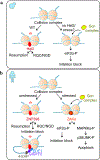A cellular handbook for collided ribosomes: surveillance pathways and collision types
- PMID: 33044589
- PMCID: PMC7887001
- DOI: 10.1007/s00294-020-01111-w
A cellular handbook for collided ribosomes: surveillance pathways and collision types
Abstract
Translating ribosomes slow down or completely stall when they encounter obstacles on mRNAs. Such events can lead to ribosomes colliding with each other and forming complexes of two (disome), three (trisome) or more ribosomes. While these events can activate surveillance pathways, it has been unclear if collisions are common on endogenous mRNAs and whether they are usually detected by these cellular pathways. Recent genome-wide surveys of collisions revealed widespread distribution of disomes and trisomes across endogenous mRNAs in eukaryotic cells. Several studies further hinted that the recognition of collisions and response to them by multiple surveillance pathways depend on the context and duration of the ribosome stalling. This review considers recent efforts in the identification of endogenous ribosome collisions and cellular pathways dedicated to sense their severity. We further discuss the potential role of collided ribosomes in modulating co-translational events and contributing to cellular homeostasis.
Keywords: Disome; Programmed ribosome stalling; Ribosome collisions; Ribosome profiling; Surveillance pathway; Trisome.
Figures


References
Publication types
MeSH terms
Substances
Grants and funding
LinkOut - more resources
Full Text Sources

